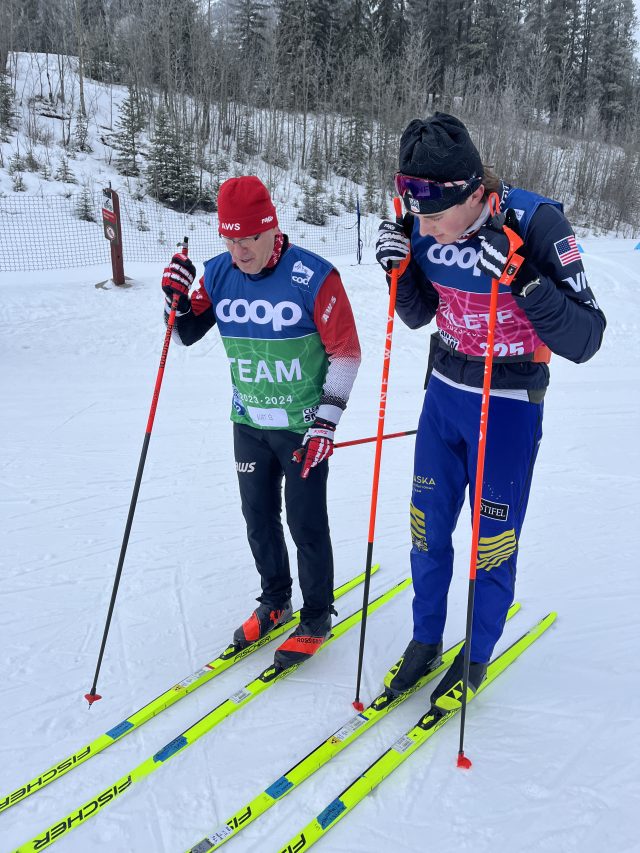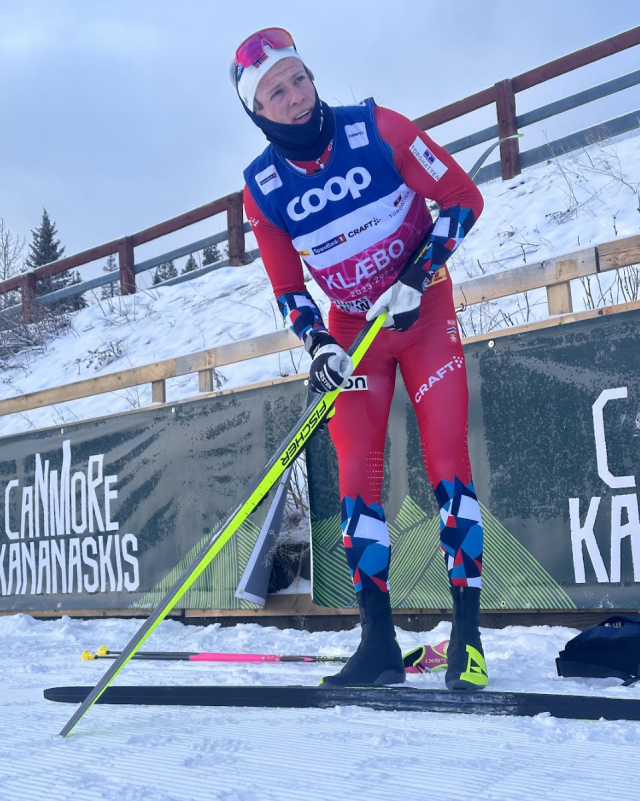
CANMORE, ALBERTA — Abbey Zimmer and Natalie Meinert peered over a railing out onto the course at the cross-country ski center here Thursday, where dozens of the world’s best athletes were amidst their pre-race routines.
The 14-year-olds had driven seven hours to Canmore with their parents from icy Saskatoon, Saskatchewan. They were there to ski on some snowy trails and for a weekend of watching racers that they normally only see on highlight reels.
“We just saw Klæbo,” said Zimmer, referring to Johannes Høsflot, the five-time Olympic gold-medal winner from Norway.
“Which was like, ‘Oh my god,’” said Meinert. “And we’re trying to find Jessie Diggins.”

Diggins, of course, was half of the team that won America’s first ever Olympic gold in cross-country skiing, in 2018.
And she is one of the stars of what is setting up to be a 10-day celebration of North American cross-country skiing, with fans expected to turn out in droves. Friday will be the first in a series of six races that mark the return of the top-level World Cup circuit to the continent for the first time since 2019 — and for the first time to the U.S. in more than two decades.
Four races are scheduled in Canmore. Two more sold-out events will take place the following weekend in Minneapolis, Diggins’ hometown, where organizers have already distributed nearly 30,000 tickets and are still getting countless requests for more.
“I wish I had a bigger urban park,” Claire Wilson, the lead organizer of the Minneapolis events, said in a message Thursday.
All the top Canadian and U.S. cross-country skiers will be competing in Canmore and Minneapolis. But one highlight of these races will be what’s known as the “nations group” — extra start spots for athletes that are granted to the countries hosting the events. (Canada and the U.S. will get the extra spots in both nations, because it’s rare that the circuit travels to either country.)
Instead of the half-dozen or so Americans and Canadians that typically compete in World Cups in Europe, as many as 12 men and 12 women from each country will start in each of the races over the next two weeks.
That means that a 17-year-old high school student from Alaska, Murphy Kimball, will be racing Saturday’s sprint alongside U.S. stars like JC Schoonmaker and Ben Ogden. Three American men — Graham Houtsma, Braden Becker and Reid Goble — and three American women — Mariah Bredal, Emma Albrecht and Margie Freed — will be making their World Cup debuts in Friday’s distance race.

In interviews Thursday, the World Cup debutants said they’re aiming to treat the events like any others — though that’s easier said than done when shuttle buses are filled with foreign languages, television cameras are everywhere and the race course is lined with banners advertising Swiss cheese.
“I’m trying to think of everyone as just normal people, because that’s who they are,” said Renae Anderson, an American racing her first World Cup on Saturday. But, she added: “It’s people I’ve been watching on TV for years.”
Anderson’s family, and some of their friends, will be in attendance in Canmore, she said, making them among the many spectators at the North American events with direct connections to athletes.
That support network will be one element of a rare home field advantage for the North Americans. Top athletes from Canada and the U.S. typically spend the full winter in Europe and face jet lag of up to 11 hours upon their arrival; this week, many of them have arrived on short flights from their homes, unlike their European competitors.
“The flight, it was really good,” said Edvin Anger, a 21-year-old sprinter from Sweden. “But the first three days were horrible for me. I woke up at 3 a.m.”

But home races also come with some complications.
The U.S. and Canadian service staffs — the crews who help athletes test skis and waxes — might typically work with as many as 10 or 12 athletes during a weekend of racing. Now, they’re trying to coordinate as many as 24 starters for each race.
Both nations are depending on regional and club coaches who have traveled to Canmore to help test skis and wax. In the case of Canada’s squad, the extra racers and staff, plus the regulars, are spread across different places in Canmore, including some who are in their own homes, said Chris Jeffries, the team’s high performance director.
That’s forced complicated logistics like a Zoom option for pre-race meetings, complete with breakout rooms.
“We have really small moments to be able to create that team culture and that team cohesion, which is not typical,” Jeffries said. “At the same time, the athletes, I think, are in a really good place.”

Not everything has gone smoothly in Canmore, however.
Early in Thursday’s training session, an up and coming Italian sprinter, Simone Mocellini, crashed on a notoriously challenging corner, flew over some protective fencing and “fell five meters down out of the track,” said Markus Cramer, his team’s coach.
Mocellini had just returned to the World Cup last month from a hand injury that kept him out of early season races. He left the venue in an ambulance and, Cramer added, has a “very complicated broken leg.”
The International Ski Federation was also forced to change the format of Friday’s race — from an individual start, time-trial style 10-kilometer race to a mass start, 15-kilometer race — after a ground crew strike at the German Lufthansa airline stranded World Cup timing equipment.
Late Tuesday, organizers began discussions with a timing company headquartered in Canmore, Zone4, about working Friday’s race, said Dan Roycroft, a former Olympic ski racer who founded the business.
The big challenge they faced was making sure that Zone4’s timing equipment would work with the television graphics systems operated by Swiss Timing, the company that typically handles both jobs.
“They normally take a month to create an interface, and we had to do it in two days,” Roycroft said Thursday, citing “amazing cooperation” with Swiss Timing. “Tomorrow, if everything goes well, then it should look like a normal World Cup.”
Roycroft said that the stranded timing equipment amounted to 18 pallets — 5,000 pounds of gear. The difference between his company’s system and the one typically used on the World Cup, he added, was underscored as he drove up to Canmore’s race venue with one Swiss Timing’s employees.
“He goes, ‘I can’t believe you can time a World Cup with stuff that just fits in one car,’” Roycroft said. He added: “It was very lucky that we’re based in Canmore, and obviously, it’s our hometown. We want this event to go as well as possible, to show what Canmore can do.”
Nathaniel Herz
Nat Herz is an Alaska-based journalist who moonlights for FasterSkier as an occasional reporter and podcast host. He was FasterSkier's full-time reporter in 2010 and 2011.



